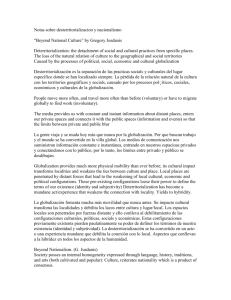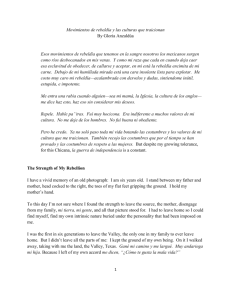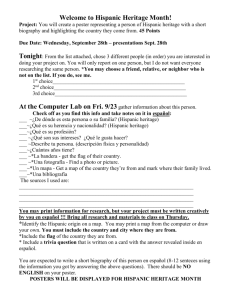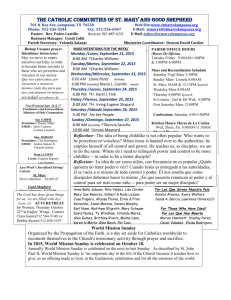COUNTRY BIRTHDAYS WEDDINGS NEW YEAR USA They are
advertisement
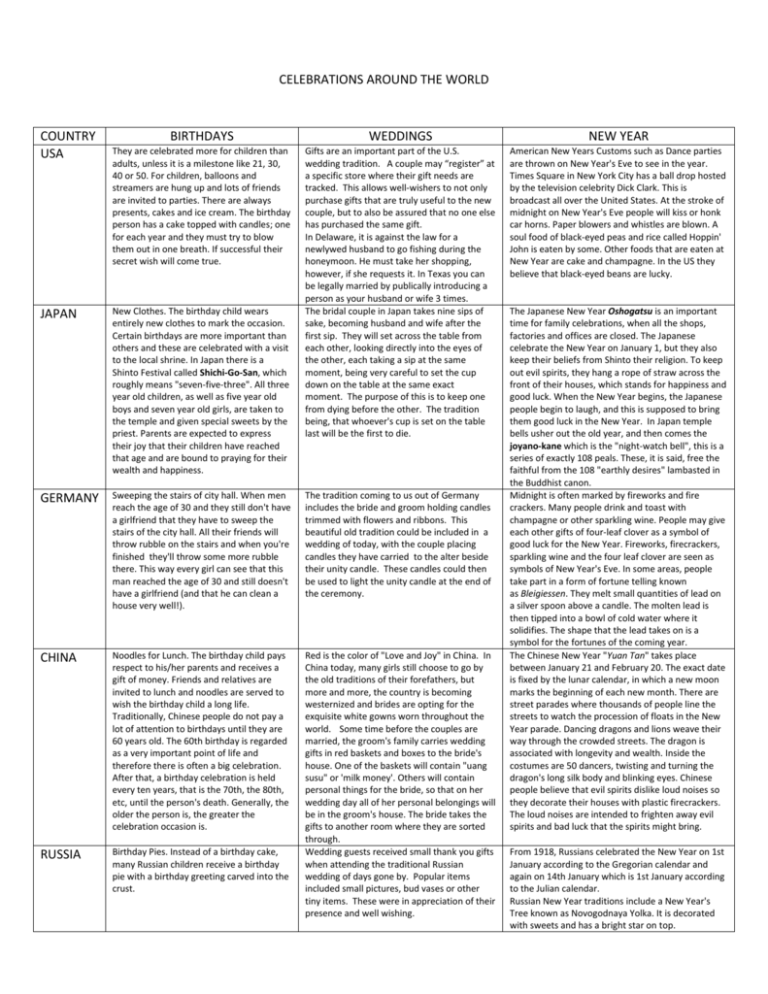
CELEBRATIONS AROUND THE WORLD COUNTRY USA BIRTHDAYS WEDDINGS NEW YEAR They are celebrated more for children than adults, unless it is a milestone like 21, 30, 40 or 50. For children, balloons and streamers are hung up and lots of friends are invited to parties. There are always presents, cakes and ice cream. The birthday person has a cake topped with candles; one for each year and they must try to blow them out in one breath. If successful their secret wish will come true. Gifts are an important part of the U.S. wedding tradition. A couple may “register” at a specific store where their gift needs are tracked. This allows well-wishers to not only purchase gifts that are truly useful to the new couple, but to also be assured that no one else has purchased the same gift. In Delaware, it is against the law for a newlywed husband to go fishing during the honeymoon. He must take her shopping, however, if she requests it. In Texas you can be legally married by publically introducing a person as your husband or wife 3 times. The bridal couple in Japan takes nine sips of sake, becoming husband and wife after the first sip. They will set across the table from each other, looking directly into the eyes of the other, each taking a sip at the same moment, being very careful to set the cup down on the table at the same exact moment. The purpose of this is to keep one from dying before the other. The tradition being, that whoever's cup is set on the table last will be the first to die. American New Years Customs such as Dance parties are thrown on New Year's Eve to see in the year. Times Square in New York City has a ball drop hosted by the television celebrity Dick Clark. This is broadcast all over the United States. At the stroke of midnight on New Year's Eve people will kiss or honk car horns. Paper blowers and whistles are blown. A soul food of black-eyed peas and rice called Hoppin' John is eaten by some. Other foods that are eaten at New Year are cake and champagne. In the US they believe that black-eyed beans are lucky. JAPAN New Clothes. The birthday child wears entirely new clothes to mark the occasion. Certain birthdays are more important than others and these are celebrated with a visit to the local shrine. In Japan there is a Shinto Festival called Shichi-Go-San, which roughly means "seven-five-three". All three year old children, as well as five year old boys and seven year old girls, are taken to the temple and given special sweets by the priest. Parents are expected to express their joy that their children have reached that age and are bound to praying for their wealth and happiness. GERMANY Sweeping the stairs of city hall. When men reach the age of 30 and they still don't have a girlfriend that they have to sweep the stairs of the city hall. All their friends will throw rubble on the stairs and when you're finished they'll throw some more rubble there. This way every girl can see that this man reached the age of 30 and still doesn't have a girlfriend (and that he can clean a house very well!). The tradition coming to us out of Germany includes the bride and groom holding candles trimmed with flowers and ribbons. This beautiful old tradition could be included in a wedding of today, with the couple placing candles they have carried to the alter beside their unity candle. These candles could then be used to light the unity candle at the end of the ceremony. CHINA Noodles for Lunch. The birthday child pays respect to his/her parents and receives a gift of money. Friends and relatives are invited to lunch and noodles are served to wish the birthday child a long life. Traditionally, Chinese people do not pay a lot of attention to birthdays until they are 60 years old. The 60th birthday is regarded as a very important point of life and therefore there is often a big celebration. After that, a birthday celebration is held every ten years, that is the 70th, the 80th, etc, until the person's death. Generally, the older the person is, the greater the celebration occasion is. RUSSIA Birthday Pies. Instead of a birthday cake, many Russian children receive a birthday pie with a birthday greeting carved into the crust. Red is the color of "Love and Joy" in China. In China today, many girls still choose to go by the old traditions of their forefathers, but more and more, the country is becoming westernized and brides are opting for the exquisite white gowns worn throughout the world. Some time before the couples are married, the groom's family carries wedding gifts in red baskets and boxes to the bride's house. One of the baskets will contain "uang susu" or 'milk money'. Others will contain personal things for the bride, so that on her wedding day all of her personal belongings will be in the groom's house. The bride takes the gifts to another room where they are sorted through. Wedding guests received small thank you gifts when attending the traditional Russian wedding of days gone by. Popular items included small pictures, bud vases or other tiny items. These were in appreciation of their presence and well wishing. The Japanese New Year Oshogatsu is an important time for family celebrations, when all the shops, factories and offices are closed. The Japanese celebrate the New Year on January 1, but they also keep their beliefs from Shinto their religion. To keep out evil spirits, they hang a rope of straw across the front of their houses, which stands for happiness and good luck. When the New Year begins, the Japanese people begin to laugh, and this is supposed to bring them good luck in the New Year. In Japan temple bells usher out the old year, and then comes the joyano-kane which is the "night-watch bell", this is a series of exactly 108 peals. These, it is said, free the faithful from the 108 "earthly desires" lambasted in the Buddhist canon. Midnight is often marked by fireworks and fire crackers. Many people drink and toast with champagne or other sparkling wine. People may give each other gifts of four-leaf clover as a symbol of good luck for the New Year. Fireworks, firecrackers, sparkling wine and the four leaf clover are seen as symbols of New Year's Eve. In some areas, people take part in a form of fortune telling known as Bleigiessen. They melt small quantities of lead on a silver spoon above a candle. The molten lead is then tipped into a bowl of cold water where it solidifies. The shape that the lead takes on is a symbol for the fortunes of the coming year. The Chinese New Year "Yuan Tan" takes place between January 21 and February 20. The exact date is fixed by the lunar calendar, in which a new moon marks the beginning of each new month. There are street parades where thousands of people line the streets to watch the procession of floats in the New Year parade. Dancing dragons and lions weave their way through the crowded streets. The dragon is associated with longevity and wealth. Inside the costumes are 50 dancers, twisting and turning the dragon's long silk body and blinking eyes. Chinese people believe that evil spirits dislike loud noises so they decorate their houses with plastic firecrackers. The loud noises are intended to frighten away evil spirits and bad luck that the spirits might bring. From 1918, Russians celebrated the New Year on 1st January according to the Gregorian calendar and again on 14th January which is 1st January according to the Julian calendar. Russian New Year traditions include a New Year's Tree known as Novogodnaya Yolka. It is decorated with sweets and has a bright star on top. .- ¿En qué casos los cumpleaños en Estados Unidos es importante que se festejen para los adultos? 2.- ¿Qué se prohíbe en Delaware hacer durante la luna de miel? 3.- Que se consume tradicionalmente en Estados Unidos en la celebración del año nuevo y cuál es la razón? 4.-¿ En Japón por qué se llama así el Festival “Shichi-Go-San” y quiénes van ahí? 5.- En Japón, ¿qué y cuanto bebe la pareja al casarse y que propósito tiene? ¿En qué momento quedan casados? 6.-En Japón, ¿Cuál es el propósito de colgar una soga en frente de sus casas durante la celebración del año nuevo? 7.- En Alemania, ¿Qué tienen que hacer los hombre que ya cumplieron 30 años y aun no tienen novia y que es lo que debe hacer sus amigos? 8.- En Alemania, qué es lo que llevan los novios al casarse en su camino al altar? 9.- ¿Cuáles son los símbolos de la víspera del año nuevo en Alemania? 10.- ¿Cuál son los cumpleaños más importante en China? 11.- ¿Para qué se sirven fideos en los cumpleaños de los niños en China? 12.- ¿Qué es lo que lleva la familia del novio a la casa de la novia? 13.- ¿Cuándo se celebra el año nuevo chino? 14.- ¿Con qué se asocian los dragones que desfilan en las calles de China durante la celebración del año nuevo? 15.- ¿Por qué motivo los chinos decoran sus casas con petardos de plástico durante la celebración del año nuevo? 16.- En Rusia, ¿ qué es lo que reciben los niño en su cumpleaños? 17.- ¿Qué es lo que reciben los invitados a una boda en Rusia? 18.- ¿Por qué en Rusia se festeja dos veces el año nuevo? 19.- Por qué en Japón se dan 108 campanadas para festejar la llegada del año nuevo? 20.- ¿Por qué en Alemania se vacía en un recipiente plomo derretido durante los festejos del año nuevo?



